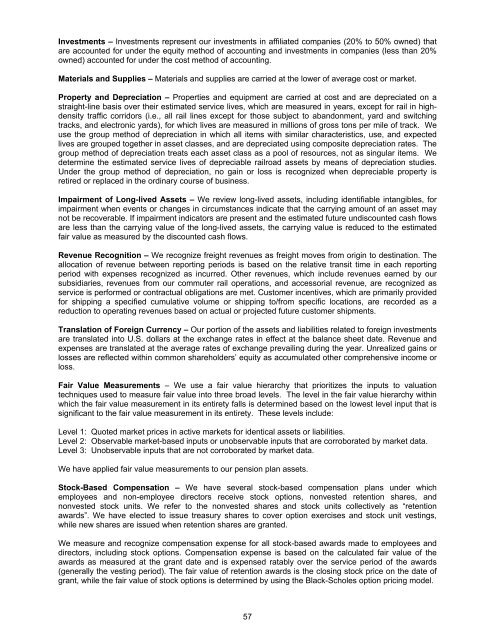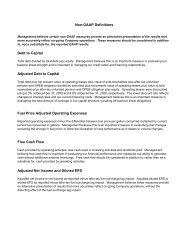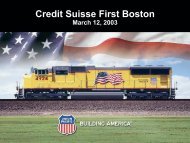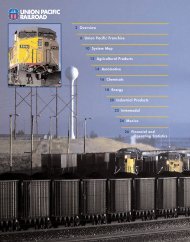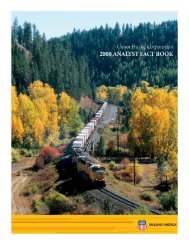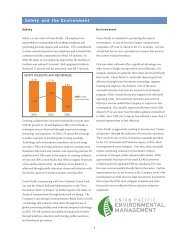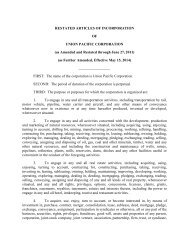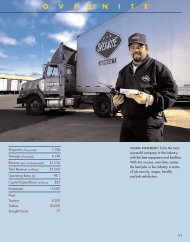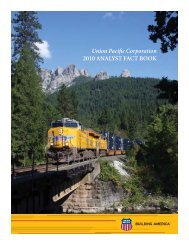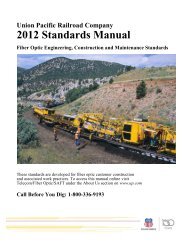Form 10-K - Union Pacific
Form 10-K - Union Pacific
Form 10-K - Union Pacific
You also want an ePaper? Increase the reach of your titles
YUMPU automatically turns print PDFs into web optimized ePapers that Google loves.
Investments – Investments represent our investments in affiliated companies (20% to 50% owned) that<br />
are accounted for under the equity method of accounting and investments in companies (less than 20%<br />
owned) accounted for under the cost method of accounting.<br />
Materials and Supplies – Materials and supplies are carried at the lower of average cost or market.<br />
Property and Depreciation – Properties and equipment are carried at cost and are depreciated on a<br />
straight-line basis over their estimated service lives, which are measured in years, except for rail in highdensity<br />
traffic corridors (i.e., all rail lines except for those subject to abandonment, yard and switching<br />
tracks, and electronic yards), for which lives are measured in millions of gross tons per mile of track. We<br />
use the group method of depreciation in which all items with similar characteristics, use, and expected<br />
lives are grouped together in asset classes, and are depreciated using composite depreciation rates. The<br />
group method of depreciation treats each asset class as a pool of resources, not as singular items. We<br />
determine the estimated service lives of depreciable railroad assets by means of depreciation studies.<br />
Under the group method of depreciation, no gain or loss is recognized when depreciable property is<br />
retired or replaced in the ordinary course of business.<br />
Impairment of Long-lived Assets – We review long-lived assets, including identifiable intangibles, for<br />
impairment when events or changes in circumstances indicate that the carrying amount of an asset may<br />
not be recoverable. If impairment indicators are present and the estimated future undiscounted cash flows<br />
are less than the carrying value of the long-lived assets, the carrying value is reduced to the estimated<br />
fair value as measured by the discounted cash flows.<br />
Revenue Recognition – We recognize freight revenues as freight moves from origin to destination. The<br />
allocation of revenue between reporting periods is based on the relative transit time in each reporting<br />
period with expenses recognized as incurred. Other revenues, which include revenues earned by our<br />
subsidiaries, revenues from our commuter rail operations, and accessorial revenue, are recognized as<br />
service is performed or contractual obligations are met. Customer incentives, which are primarily provided<br />
for shipping a specified cumulative volume or shipping to/from specific locations, are recorded as a<br />
reduction to operating revenues based on actual or projected future customer shipments.<br />
Translation of Foreign Currency – Our portion of the assets and liabilities related to foreign investments<br />
are translated into U.S. dollars at the exchange rates in effect at the balance sheet date. Revenue and<br />
expenses are translated at the average rates of exchange prevailing during the year. Unrealized gains or<br />
losses are reflected within common shareholders’ equity as accumulated other comprehensive income or<br />
loss.<br />
Fair Value Measurements – We use a fair value hierarchy that prioritizes the inputs to valuation<br />
techniques used to measure fair value into three broad levels. The level in the fair value hierarchy within<br />
which the fair value measurement in its entirety falls is determined based on the lowest level input that is<br />
significant to the fair value measurement in its entirety. These levels include:<br />
Level 1: Quoted market prices in active markets for identical assets or liabilities.<br />
Level 2: Observable market-based inputs or unobservable inputs that are corroborated by market data.<br />
Level 3: Unobservable inputs that are not corroborated by market data.<br />
We have applied fair value measurements to our pension plan assets.<br />
Stock-Based Compensation – We have several stock-based compensation plans under which<br />
employees and non-employee directors receive stock options, nonvested retention shares, and<br />
nonvested stock units. We refer to the nonvested shares and stock units collectively as “retention<br />
awards”. We have elected to issue treasury shares to cover option exercises and stock unit vestings,<br />
while new shares are issued when retention shares are granted.<br />
We measure and recognize compensation expense for all stock-based awards made to employees and<br />
directors, including stock options. Compensation expense is based on the calculated fair value of the<br />
awards as measured at the grant date and is expensed ratably over the service period of the awards<br />
(generally the vesting period). The fair value of retention awards is the closing stock price on the date of<br />
grant, while the fair value of stock options is determined by using the Black-Scholes option pricing model.<br />
57


